key TOYOTA YARIS 2013 Workshop Manual
[x] Cancel search | Manufacturer: TOYOTA, Model Year: 2013, Model line: YARIS, Model: TOYOTA YARIS 2013Pages: 712, PDF Size: 30.2 MB
Page 180 of 712
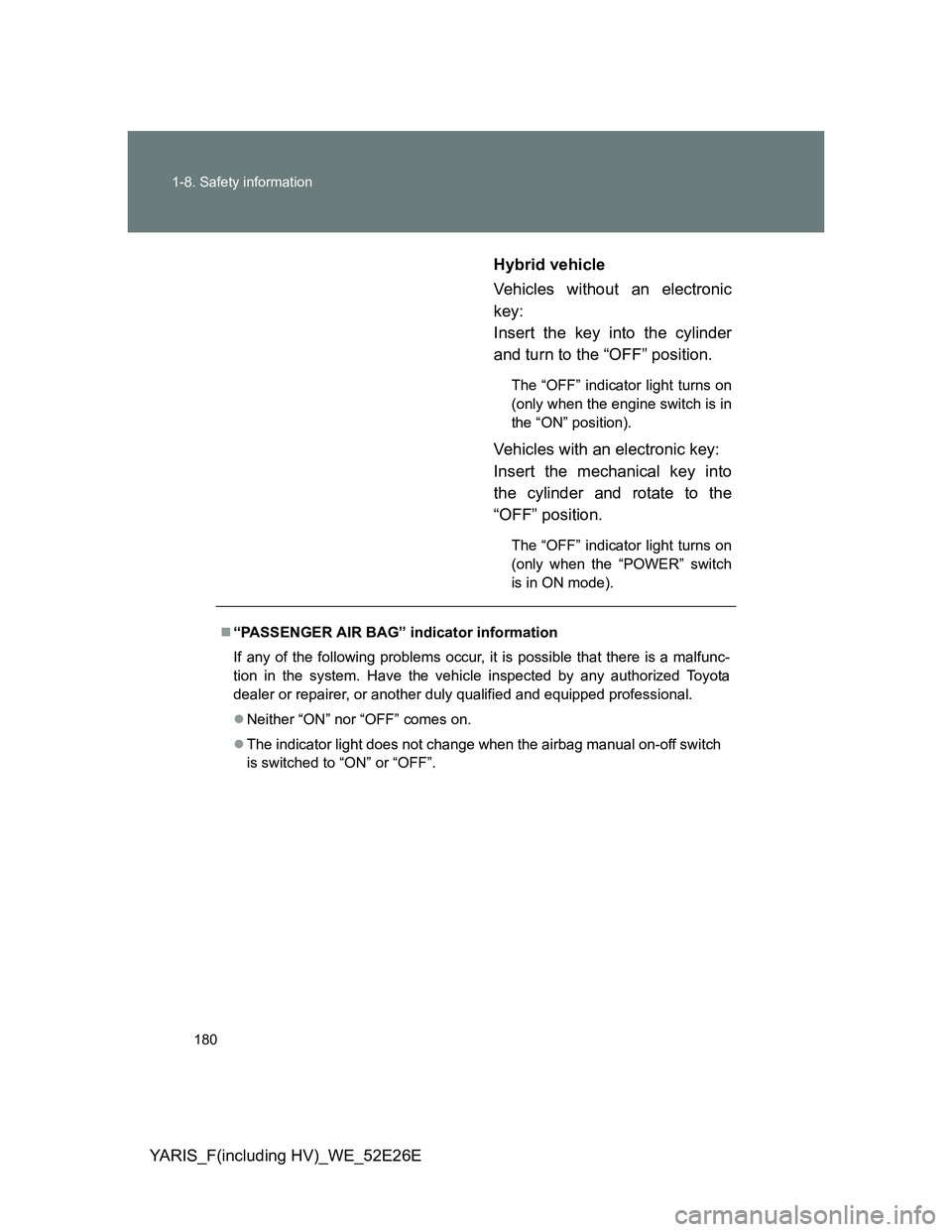
180 1-8. Safety information
YARIS_F(including HV)_WE_52E26EHybrid vehicle
Vehicles without an electronic
key:
Insert the key into the cylinder
and turn to the “OFF” position.
The “OFF” indicator light turns on
(only when the engine switch is in
the “ON” position).
Vehicles with an electronic key:
Insert the mechanical key into
the cylinder and rotate to the
“OFF” position.
The “OFF” indicator light turns on
(only when the “POWER” switch
is in ON mode).
“PASSENGER AIR BAG” indicator information
If any of the following problems occur, it is possible that there is a malfunc-
tion in the system. Have the vehicle inspected by any authorized Toyota
dealer or repairer, or another duly qualified and equipped professional.
Neither “ON” nor “OFF” comes on.
The indicator light does not change when the airbag manual on-off switch
is switched to “ON” or “OFF”.
Page 185 of 712
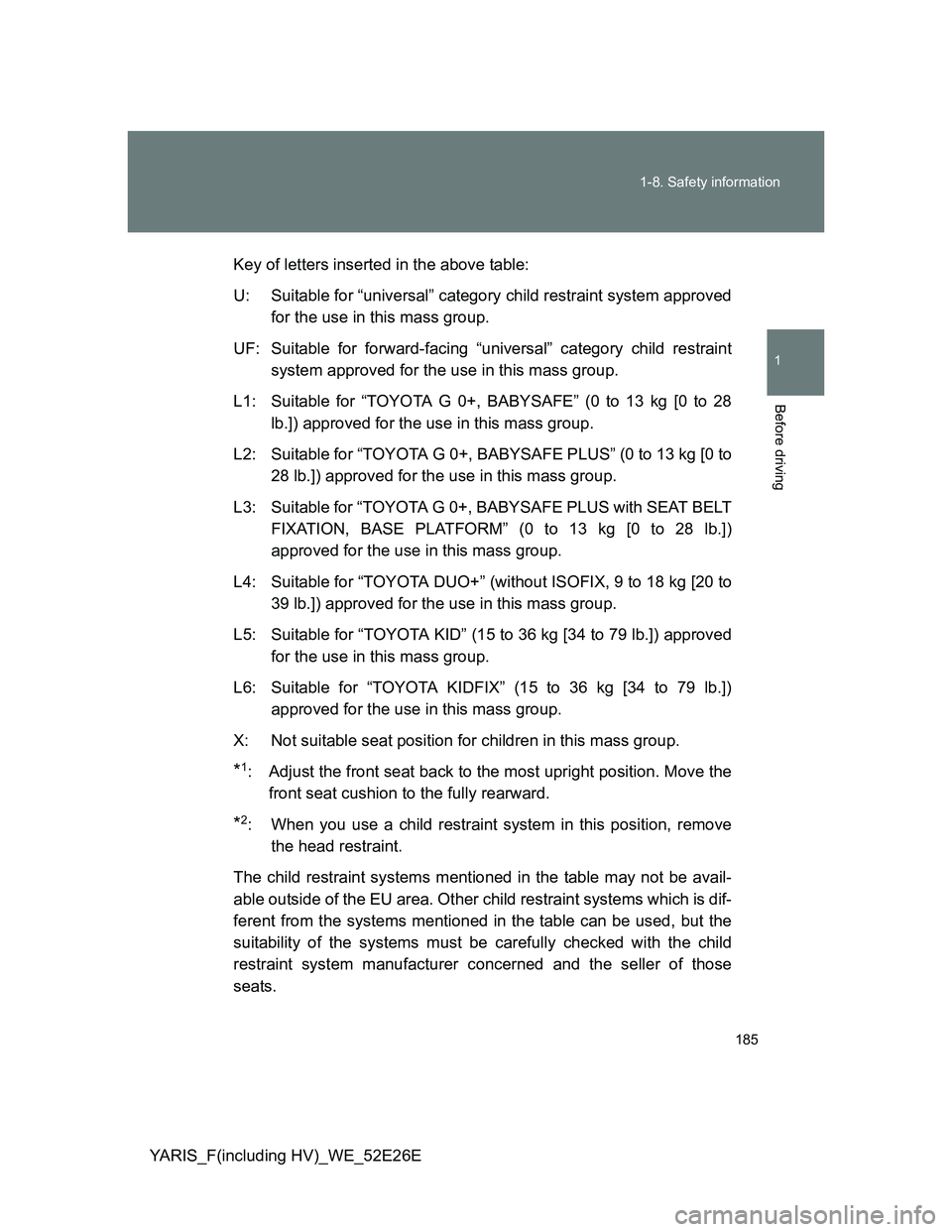
185 1-8. Safety information
1
Before driving
YARIS_F(including HV)_WE_52E26EKey of letters inserted in the above table:
U: Suitable for “universal” category child restraint system approved
for the use in this mass group.
UF: Suitable for forward-facing “universal” category child restraint
system approved for the use in this mass group.
L1: Suitable for “TOYOTA G 0+, BABYSAFE” (0 to 13 kg [0 to 28
lb.]) approved for the use in this mass group.
L2: Suitable for “TOYOTA G 0+, BABYSAFE PLUS” (0 to 13 kg [0 to
28 lb.]) approved for the use in this mass group.
L3: Suitable for “TOYOTA G 0+, BABYSAFE PLUS with SEAT BELT
FIXATION, BASE PLATFORM” (0 to 13 kg [0 to 28 lb.])
approved for the use in this mass group.
L4: Suitable for “TOYOTA DUO+” (without ISOFIX, 9 to 18 kg [20 to
39 lb.]) approved for the use in this mass group.
L5: Suitable for “TOYOTA KID” (15 to 36 kg [34 to 79 lb.]) approved
for the use in this mass group.
L6: Suitable for “TOYOTA KIDFIX” (15 to 36 kg [34 to 79 lb.])
approved for the use in this mass group.
X: Not suitable seat position for children in this mass group.
*1: Adjust the front seat back to the most upright position. Move the
front seat cushion to the fully rearward.
*2: When you use a child restraint system in this position, remove
the head restraint.
The child restraint systems mentioned in the table may not be avail-
able outside of the EU area. Other child restraint systems which is dif-
ferent from the systems mentioned in the table can be used, but the
suitability of the systems must be carefully checked with the child
restraint system manufacturer concerned and the seller of those
seats.
Page 187 of 712

187 1-8. Safety information
1
Before driving
YARIS_F(including HV)_WE_52E26E(1) For the CRS which do not carry the ISO/XX size class identifica-
tion (A to G), for the applicable mass group, the car manufac-
turer shall indicate the vehicle specific ISOFIX child restraint
system(s) recommended for each position.
Key of letters inserted in the above table:
IUF: Suitable for ISOFIX forward-facing child restraints systems of
universal category approved for the use in this mass group.
IL1: Suitable for “TOYOTA G 0+, BABYSAFE PLUS with ISO-FIX
FIXATION, BASE PLATFORM” (0 to 13 kg [0 to 28 lb.])
approved for the use in this mass group.
X: ISOFIX position not suitable for ISOFIX child restraint systems
in this mass group and/or this size class.
*1: If the child seat is installed behind a front seat equipped with
height adjuster and the front seat is adjusted below middle
height position, then adjust the front seat head restraint to the
highest position.
*2: When you use a child restraint system in this position, remove
the head restraint.
*3: Toyota recommend to use “TOYOTA DUO+” (with ISOFIX and
TOP TETHER, 9 to 18 kg [20 to 39 lb.]) approved for the use in
this mass group. When using this child seat, adjust it to the most
reclined position.
The child restraint systems mentioned in the table may not be avail-
able outside of the EU area. Other child restraint systems different
from the systems mentioned in the table can be used, but the suitabil-
ity of the systems must be carefully checked with the child restraint
system manufacturer and retailer.
Page 201 of 712

2When driving
201
YARIS_F(including HV)_WE_52E26E
2-1. Driving procedures
Driving the vehicle ............ 202
Engine (ignition) switch
(except hybrid vehicle
[vehicles without a smart
entry & start system])...... 222
Engine (ignition) switch
(except hybrid vehicle
[vehicles with a smart
entry & start system])...... 226
Engine (ignition) switch
(hybrid vehicle [vehicles
without an electronic
key]) ................................ 236
Power (ignition) switch
(hybrid vehicle [vehicles
with an electronic key]) ... 241
EV drive mode
(hybrid vehicle) ............... 248
Hybrid transmission .......... 250
Multidrive .......................... 253
Multi-mode manual
transmission ................... 258
Manual transmission......... 263
Turn signal lever ............... 267
Parking brake ................... 269
Horn .................................. 270
2-2. Instrument cluster
Gauges and meters .......... 271
Indicators and warning
lights ............................... 276
Multi-information display ... 2842-3. Operating the lights and
wipers
Headlight switch................ 291
Fog light switch ................. 300
Windshield wiper and
washer ............................ 302
Rear window wiper and
washer ............................ 307
2-4. Using other driving systems
Cruise control.................... 309
Speed limiter ..................... 313
Stop & Start system .......... 316
Driving assist systems ...... 324
Hill-start assist control
(hybrid vehicle) ............... 330
Diesel particulate filter
system ............................ 332
2-5. Driving information
Cargo and luggage ........... 334
Winter driving tips ............. 336
Trailer towing
(hybrid vehicle) ............... 340
Trailer towing (except
hybrid vehicle [except for
South Africa]) .................. 341
Page 204 of 712
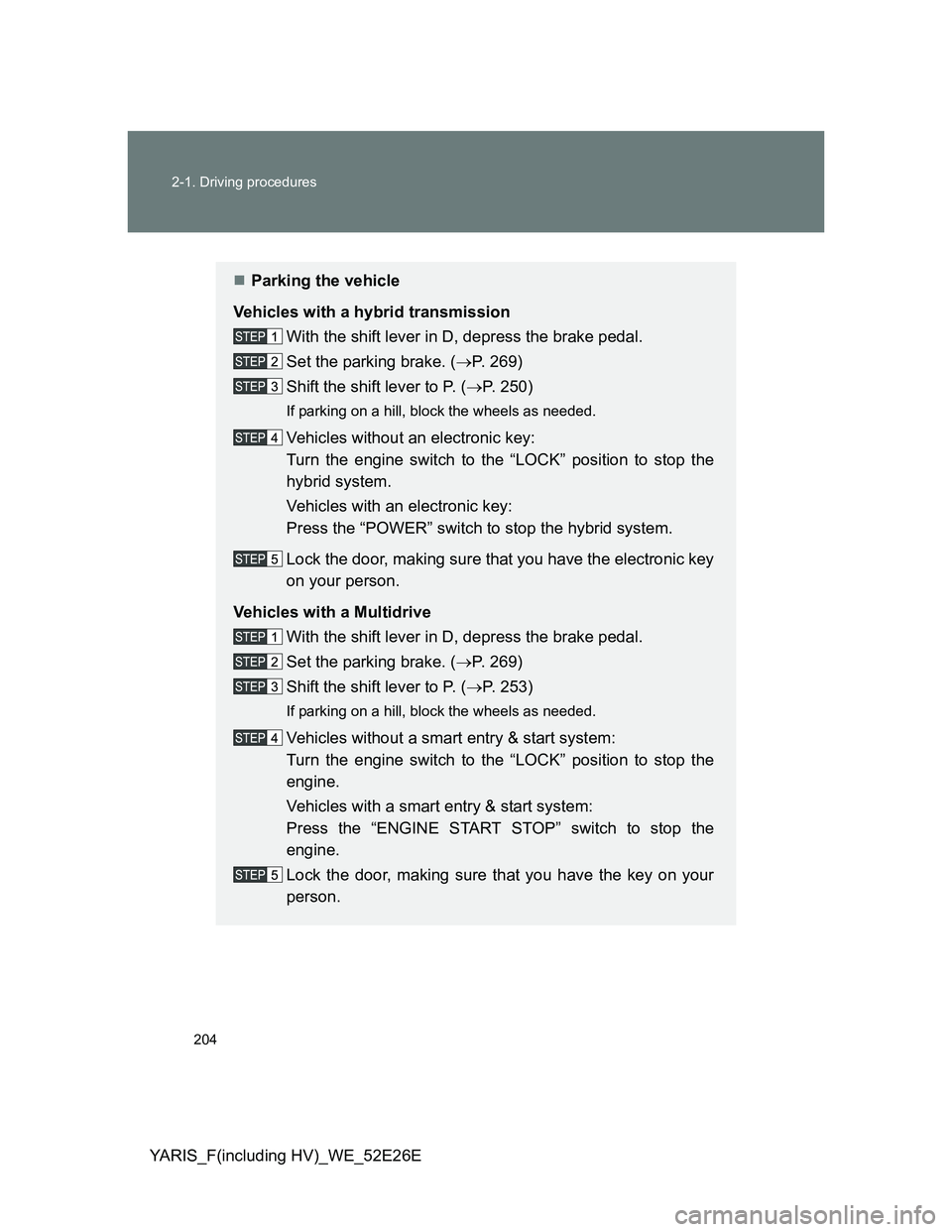
204 2-1. Driving procedures
YARIS_F(including HV)_WE_52E26E
Parking the vehicle
Vehicles with a hybrid transmission
With the shift lever in D, depress the brake pedal.
Set the parking brake. (P. 269)
Shift the shift lever to P. (P. 250)
If parking on a hill, block the wheels as needed.
Vehicles without an electronic key:
Turn the engine switch to the “LOCK” position to stop the
hybrid system.
Vehicles with an electronic key:
Press the “POWER” switch to stop the hybrid system.
Lock the door, making sure that you have the electronic key
on your person.
Vehicles with a Multidrive
With the shift lever in D, depress the brake pedal.
Set the parking brake. (P. 269)
Shift the shift lever to P. (P. 253)
If parking on a hill, block the wheels as needed.
Vehicles without a smart entry & start system:
Turn the engine switch to the “LOCK” position to stop the
engine.
Vehicles with a smart entry & start system:
Press the “ENGINE START STOP” switch to stop the
engine.
Lock the door, making sure that you have the key on your
person.
Page 205 of 712
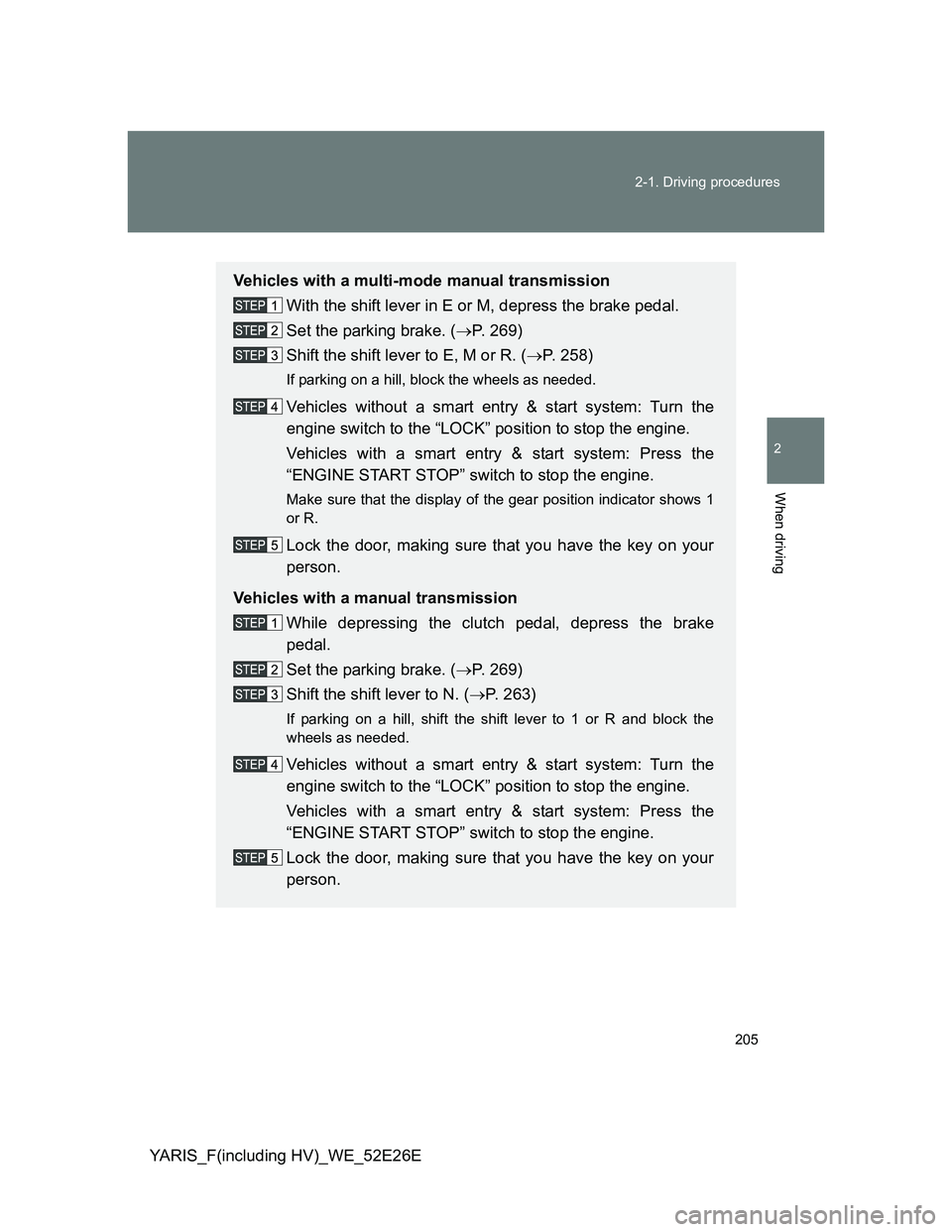
205 2-1. Driving procedures
2
When driving
YARIS_F(including HV)_WE_52E26E
Vehicles with a multi-mode manual transmission
With the shift lever in E or M, depress the brake pedal.
Set the parking brake. (P. 269)
Shift the shift lever to E, M or R. (P. 258)
If parking on a hill, block the wheels as needed.
Vehicles without a smart entry & start system: Turn the
engine switch to the “LOCK” position to stop the engine.
Vehicles with a smart entry & start system: Press the
“ENGINE START STOP” switch to stop the engine.
Make sure that the display of the gear position indicator shows 1
or R.
Lock the door, making sure that you have the key on your
person.
Vehicles with a manual transmission
While depressing the clutch pedal, depress the brake
pedal.
Set the parking brake. (P. 269)
Shift the shift lever to N. (P. 263)
If parking on a hill, shift the shift lever to 1 or R and block the
wheels as needed.
Vehicles without a smart entry & start system: Turn the
engine switch to the “LOCK” position to stop the engine.
Vehicles with a smart entry & start system: Press the
“ENGINE START STOP” switch to stop the engine.
Lock the door, making sure that you have the key on your
person.
Page 223 of 712

223 2-1. Driving procedures
2
When driving
YARIS_F(including HV)_WE_52E26E
Vehicles with a manual transmission (diesel engine)
Check that the parking brake is set.
Check that the shift lever is set in N.
Firmly depress the clutch pedal.
Turn the engine switch to the “ON” position.
The indicator turns on.
After the indicator light goes out, turn the engine
switch to the “START” position to start the engine.
Changing the engine switch positions
“LOCK”
The steering wheel is locked
and the key can be removed.
(Vehicles with a Multidrive: The
key can be removed only when
the shift lever is in P.)
“ACC”
Some electrical components
such as the audio system can
be used.
“ON”
All electrical components can
be used.
“START”
For starting the engine.
Page 224 of 712
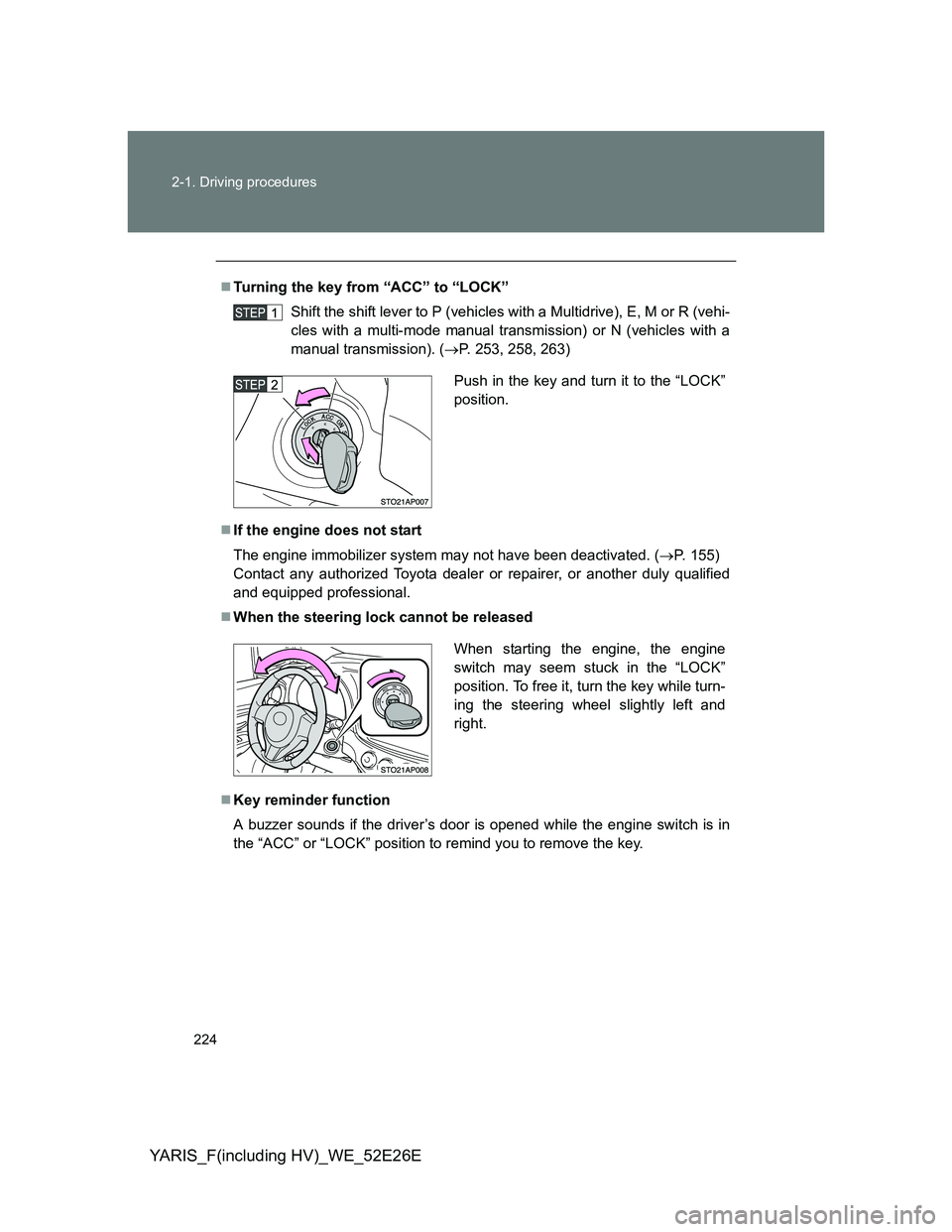
224 2-1. Driving procedures
YARIS_F(including HV)_WE_52E26E
Turning the key from “ACC” to “LOCK”
Shift the shift lever to P (vehicles with a Multidrive), E, M or R (vehi-
cles with a multi-mode manual transmission) or N (vehicles with a
manual transmission). (P. 253, 258, 263)
If the engine does not start
The engine immobilizer system may not have been deactivated. (P. 155)
Contact any authorized Toyota dealer or repairer, or another duly qualified
and equipped professional.
When the steering lock cannot be released
Key reminder function
A buzzer sounds if the driver’s door is opened while the engine switch is in
the “ACC” or “LOCK” position to remind you to remove the key.
Push in the key and turn it to the “LOCK”
position.
When starting the engine, the engine
switch may seem stuck in the “LOCK”
position. To free it, turn the key while turn-
ing the steering wheel slightly left and
right.
Page 226 of 712
![TOYOTA YARIS 2013 Workshop Manual 226
2-1. Driving procedures
YARIS_F(including HV)_WE_52E26E
Engine (ignition) switch (except hybrid vehicle [vehicles with a smart entr y & start system])
Performing the following operations when carr TOYOTA YARIS 2013 Workshop Manual 226
2-1. Driving procedures
YARIS_F(including HV)_WE_52E26E
Engine (ignition) switch (except hybrid vehicle [vehicles with a smart entr y & start system])
Performing the following operations when carr](/img/14/49157/w960_49157-225.png)
226
2-1. Driving procedures
YARIS_F(including HV)_WE_52E26E
Engine (ignition) switch (except hybrid vehicle [vehicles with a smart entr y & start system])
Performing the following operations when carrying the electronic
key on your person starts the engine or changes “ENGINE START
STOP” switch modes.
Starting the engine
Vehicles with a Multidrive
Check that the parking brake is set.
Check that the shift lever is set in P.
If the shift lever is not set in P, the engine may not be started.
(P. 253)
Firmly depress the brake pedal.
The smart entry & start system indicator light (green) will turn on.
If the indicator light does not turn on, the engine cannot be
started.
Press the “ENGINE START
STOP” switch.
The engine will crank until it
starts or for up to 30 seconds,
whichever is less.
Continue depressing the brake
pedal until the engine is com-
pletely started.
The engine can be started
from any “ENGINE START
STOP” switch mode.
Page 231 of 712
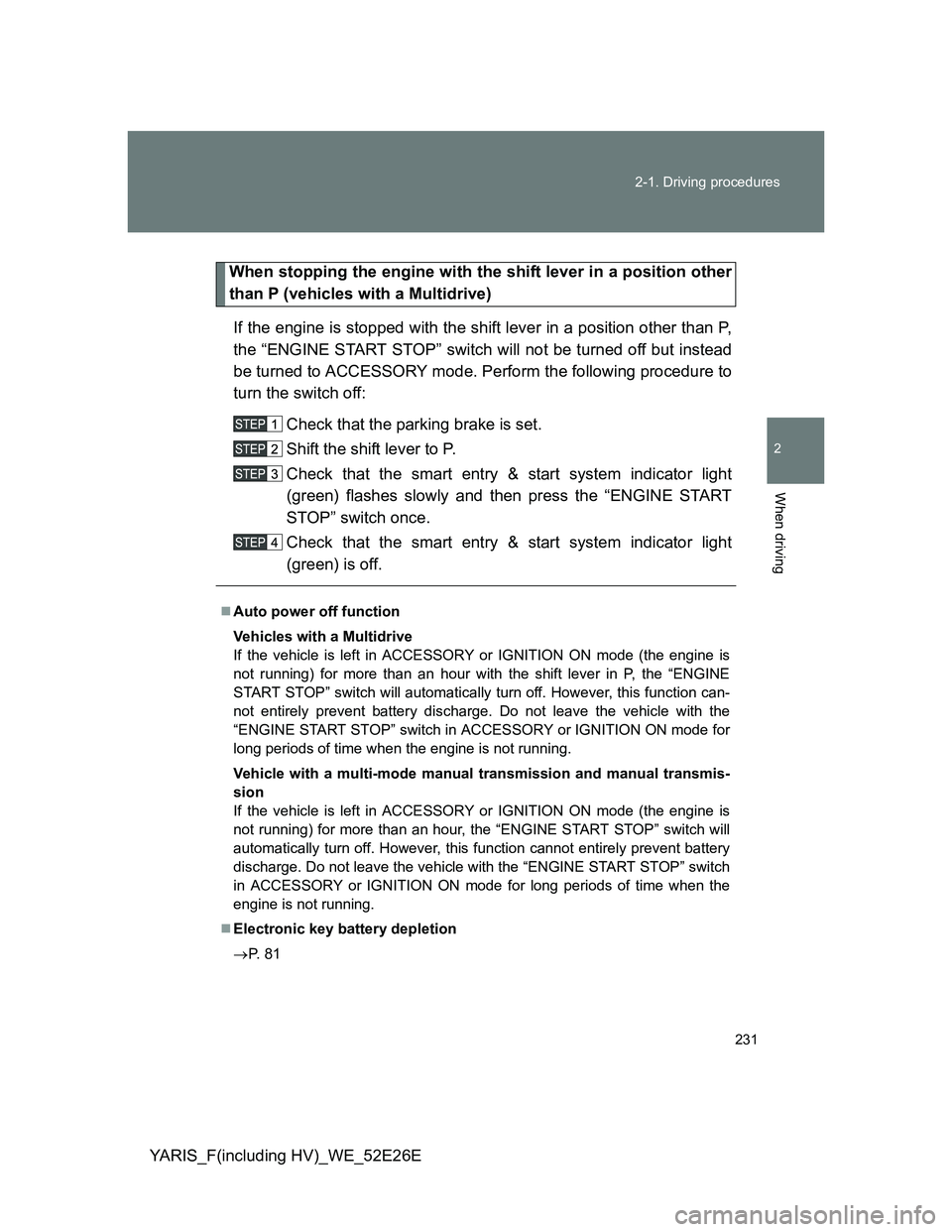
231 2-1. Driving procedures
2
When driving
YARIS_F(including HV)_WE_52E26E
When stopping the engine with the shift lever in a position other
than P (vehicles with a Multidrive)
If the engine is stopped with the shift lever in a position other than P,
the “ENGINE START STOP” switch will not be turned off but instead
be turned to ACCESSORY mode. Perform the following procedure to
turn the switch off:
Check that the parking brake is set.
Shift the shift lever to P.
Check that the smart entry & start system indicator light
(green) flashes slowly and then press the “ENGINE START
STOP” switch once.
Check that the smart entry & start system indicator light
(green) is off.
Auto power off function
Vehicles with a Multidrive
If the vehicle is left in ACCESSORY or IGNITION ON mode (the engine is
not running) for more than an hour with the shift lever in P, the “ENGINE
START STOP” switch will automatically turn off. However, this function can-
not entirely prevent battery discharge. Do not leave the vehicle with the
“ENGINE START STOP” switch in ACCESSORY or IGNITION ON mode for
long periods of time when the engine is not running.
Vehicle with a multi-mode manual transmission and manual transmis-
sion
If the vehicle is left in ACCESSORY or IGNITION ON mode (the engine is
not running) for more than an hour, the “ENGINE START STOP” switch will
automatically turn off. However, this function cannot entirely prevent battery
discharge. Do not leave the vehicle with the “ENGINE START STOP” switch
in ACCESSORY or IGNITION ON mode for long periods of time when the
engine is not running.
Electronic key battery depletion
P. 8 1